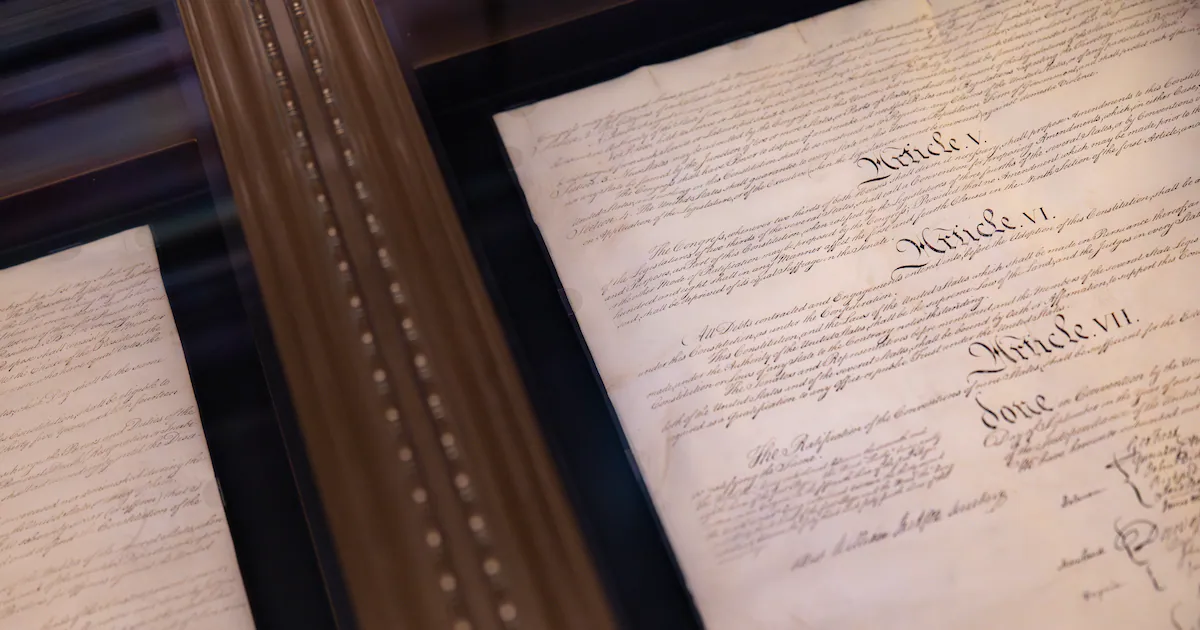
A rare sight has awaited visitors to the dimly lit Rotunda of the National Archives Building since mid-September. For the first time in the country’s history, the entirety of the U.S. Constitution, the Bill of Rights and the Constitution’s additional 17 amendments are on display together.
Tourists, locals, historians and the constitutionally curious have lined up each day outside the mausoleum-like room for an opportunity to peer at the hallowed, occasionally altered recipe for the republic. Many expressed awe of its audacious aspiration to “form a more perfect Union, establish Justice, insure domestic Tranquility, provide for the common defence, promote the general Welfare, and secure the Blessings of Liberty to ourselves and our Posterity.”
But, many too, were uneasy about its staying power. In interviews after leaving the exhibit this month in Washington, D.C., visitors expressed deep pride in the nation’s guiding document as well as profound concerns about the country’s future. While the physical documents are secured in bulletproof, climate-controlled cases, visitors said it is its spirit and resoluteness they worry about. Domestic tranquility, they say, has been in short supply. A more perfect union feels further away, not closer.
Mike Arellano, 67, from Southern California visited the display with his wife on Thursday. Arellano, who described himself as conservative, said that it “felt really good to see how all of this started” but that he’s worried “about all this hate” in the country. He mentioned politically motivated murders and attacks.
“It looks like we might go into a civil war, if you ask me,” he said “It’s crazy.”
Heidi Traeger, 68, of Sandown, New Hampshire, is also worried about the direction of the country and wonders whether the Constitution will be strong enough to keep the nation on the rails. An independent, she said she walked out of the exhibit feeling grief. “We’re experiencing a loss,” she said. “And I feel like we’re on the cusp of losing so much more of our freedom.”
For Theodore Skinner, 28, seeing the exhibit made him think differently about the Constitution. He had viewed it primarily as a document that placed limitations on the process of government. But he said as he learned more about the debate and compromise required for its creation, he came to see it as a document that pulled together people holding very different views.
“It’s not just a preamble or prologue for the country; it’s a living document,” said Skinner, who was visiting from San Diego. “It’s the amendments and their ratification that keep us together. Not everyone will agree on all of it or like it, but sometimes that compromise is necessary.”
The first four pages of the Constitution and the Bill of Rights, which were moved to the National Archives in 1952, have been on permanent public display in the Rotunda since 2003. The new temporary exhibit includes the rarely shown fifth page of the Constitution, a separate document signed by George Washington that describes how the Constitution will be ratified and put into effect. The exhibit also includes the 17 amendments that followed the Bill of Rights.
The display, which has been extended through Oct. 9, is part of the Archives’ celebration of the 250th anniversary of the United States.
“This extraordinary installation welcomes all Americans to celebrate the bedrock of our national life: our Constitution,” Jim Byron, senior adviser to the acting archivist, said in a statement.
The Constitution has had a long history of becoming a focus at times of national discord, Harvard historian Jill Lepore, author of a just-released book on the Constitution, “We the People,” said in an email. She pointed to examples including a period of constitutional conservatism in the 1920s that led to the decision to first publicly display the Constitution in 1924, when it was still housed at the Library of Congress. And in 1987, while the country was celebrating the Constitution’s 200th anniversary, the contentious congressional hearings over Robert Bork’s nomination to the Supreme Court became a backdrop for discussion and debate about how the Constitution should be interpreted and understood.
“Every display of the Constitution takes place in, and is a product of, a particular political moment, usually one of considerable anxiety about the durability of the Constitution,” Lepore said. “These moments also, inevitably, occasion a great deal of hand-wringing about what Americans know, or don’t know, about the Constitution.”
Jennifer Comer, 54, of Los Angeles said she was “kind of speechless” after viewing the Constitution and its amendments. “Seeing them in person has given me extra context and a better understanding of what a living document this is,” she said.
Comer, a small-business owner, was visiting the Archives after having joined about 200 other people in the “We Are America” march from Philadelphia to Washington to, organizers said, “send Congress – and most importantly, each other – a clear message: Our communities won’t stand aside while democracy is destroyed.”
The marchers carried a copy of the Constitution created by schoolchildren from across the country. Comer said she was rejuvenated by the march but “wildly concerned” about whether the country’s guiding document can survive.
“I’ve been to D.C. before, but there’s a different feel this time,” she said. “It’s almost like a cloud over this beautiful city.”
For David Pike, 60, a banker from Franklin, Wisconsin, the opportunity to see the original documents up close was a thrilling reminder of the nation’s history. But he was also struck by the changes made to it over the years, as well as the risks associated with how leaders choose to follow it.
“I think there’s a lot of uncertainty about how the Constitution is being interpreted,” Pike said. “Businesses want to have a game plan that they can trust, and right now there’s a lot of uncertainty. And that’s a hard way to do business.”
The experience of a firsthand glimpse of the Constitution was emotional as well for Abear Almora, 25, an engineer from Fort Worth in Washington on vacation.
“I’m not Republican or Democrat. I’m an American first,” Almora said after exiting the Archives last week.
It was his first time seeing the Constitution in person, and he said he doesn’t want it to be the last.
“I hope it’s not in jeopardy. I hope to God it never will be,” Almora said. “These are the basic building blocks of our country and the rules we need to follow.”



